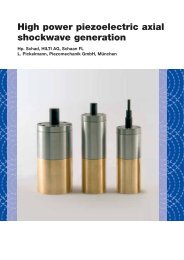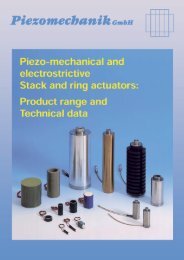231575 Piezo-Mechanics GB
231575 Piezo-Mechanics GB
231575 Piezo-Mechanics GB
Create successful ePaper yourself
Turn your PDF publications into a flip-book with our unique Google optimized e-Paper software.
5. Comparison of low voltage andhigh voltage actuators5.1. Materials, dimensionsLow voltage, co-fired stacks:The PZT material situation is no longer a concern foruse in low voltage systems as it was in the past. Inprinciple any PZT material can be used for thin-layeredco-fired systems.Low voltage and high voltage elements show the samepiezo-mechanical performance, when comparable PZTmaterial and driving fields are used.Low voltage actuators are mostly used as small andmedium sized elements with cross sections typically upto 10 x 10 mm. Larger cross sections lead to a dramaticincrease of costs. Low voltage actuators become cheapin large quantities.<strong>Piezo</strong>mechanik standard low voltage actuator rangeis aiming for an as broad as possible compromise inperformance and pricing. When you do not find a properconfiguration: contact PIEZOMECHANIK for specialsolutions.When selecting piezo-actuators, please keep in mindthe availability of driving electronics. Bulky, big volumelow voltage actuator require equivalently huge electricalcurrents in dynamic action compared to the high voltageequivalent.Discretely stacked high voltage elementsManufacturing of actuator prototypes of non-standardsize and performance is much easier for high voltageelements than with low voltage elements. All kinds ofPZT materials can easily be implemented.High voltage elements can be set up as big volumestacks for heavy load /large force/large stroke/highpower applications.5.2. Electrical propertiesThe layer structure of a piezo stack and the used PZTmaterial determine the electrical capacitance.Low voltage elements use a larger number of thinneractive layers compared to high voltage elements to getthe same active stack’s length. This results in an equivalentlyhigher electrical capacitance, but the requiredcharging power to drive a stack is the same in bothcases:When two actuators of same size, shape, and materialare built up as one 200 V element and one 1000 V element,the capacitance of the low voltage stack is largerby a factor of 25.When a driving current e.g. of 1 A is needed to get a distinctresponse from the 1000 V actuator, an equivalent200 V actuator will need 5 Amperes. The power = U · Iis the same for both cases.5.3. Temperature rangesLow voltage elements are available as special designedelements for temperatures up to approx.160 °C –180 °C.With high voltage elements, limiting temperatures of220 °C have been achieved.Cryogenic applications are feasible both for low andhigh voltage types.The important point in practice is, that any lowering ofthe max. driving voltage is accompanied by an equivalentincrease in the current levels to get a distinctdynamic response.Big volume actuators in switching application mayrequire currents up to Hundreds of Amperes, whendesigned as low voltage elements.22





